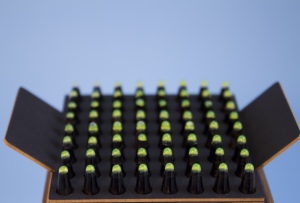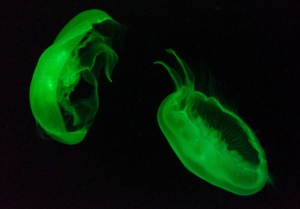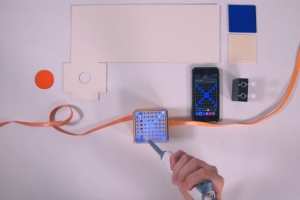
The bio-pixel display can play games Tetris

An Imperial alumus has developed a bio-pixel display that can play games such as Tetris, Snake or Pong using the protein that makes jellyfish glow
Bixel is a creative, educational tool that helps the public learn about synthetic biology, biotechnology and its applications. It was created by Cell-Free Technology, a start-up co-founded by Dyson School of Design Engineering graduate Helene Steiner.

The 8x8 bio-pixel display
Bixel is a simple self-assembly kit that allows users to build and code their own games powered by DNA. It consists of an 8x8 pixel display, programmed using jellyfish DNA to express Green Fluorescent Protein (GFP) – the material that makes jellyfish glow. The display can be manipulated with a smartphone app to activate the fluorescent colours, create messages and play simple games.
The team behind it say that it is the world’s first visual display for interacting with biological circuits.
Breakthrough technique
Cell-Free Technology were able to create Bixel after developing an innovative new technique that allows them to break open cells at large scale and extract their inner workings. It is safe, inexpensive, and does not involve the use of genetically modified organisms (GMOs).

Bixels uses jellyfish DNA
Helene said: “Playing around with DNA usually involves using GMOs, which are not considered safe to use outside of a lab. We avoid that completely by removing the components that allow the cell to replicate, including the cell wall. What’s left is a sort of biochemical soup containing the tiny machinery that is responsible for reading DNA and writing proteins – in this case GFP.”
Bixel combines coding, design, and biology, and the kit requires no background knowledge to use. Helene explained: “Our mission is to make biotechnology and synthetic biology more accessible to the public. Biotechnology is going to play an increasingly important role in our lives, and it’s crucial that the public understand it so that they can contribute meaningfully to debate about how it is used in the future. Interacting with biotechnology in this way is safe, exciting and inspirational and helps start this conversation.”
Creative applications

Helene Steiner, co-founder of Cell-Free Technology
Cell-Free Technology have also been piloting Bixels with groups of hackers, designers and people in creative industries across the UK, in the hope of encouraging then to consider and develop new applications for the technology: “We want to see biotechnology integrated seamlessly into product design – from fashion to wearable tech,” Helene said.
The team have just launched a £10,000 crowdfunding campaign to develop their product further. “Our ultimate goal is to build a personal bio-computer which, unlike current wearable devices, truly interacts with our bodies - speaking the natural languages of hormones and pheromones to give us new insights into our bodies and health,” said Helene.

Bixel is a creative, educational tool
Helene was a student on the Innovation Design Engineering course – which is delivered jointly by Imperial College London and the Royal College of Art. She is currently a lecturer in the Fashion Department of the Royal College of Art where she leads the Biological Materials initiative. Helen founded Cell-Free Technology along with physicist Dr Thomas Meany, protein engineer Ian McDermott, and robotics engineer Brian Manning.
Article text (excluding photos or graphics) available under an Attribution-NonCommercial-ShareAlike Creative Commons license.
Photos and graphics subject to third party copyright used with permission or © Imperial College London.
Reporter

Deborah Evanson
Communications Division

Contact details
Tel: +44 (0)20 7594 3921
Email: d.evanson@imperial.ac.uk
Show all stories by this author



Leave a comment
Your comment may be published, displaying your name as you provide it, unless you request otherwise. Your contact details will never be published.